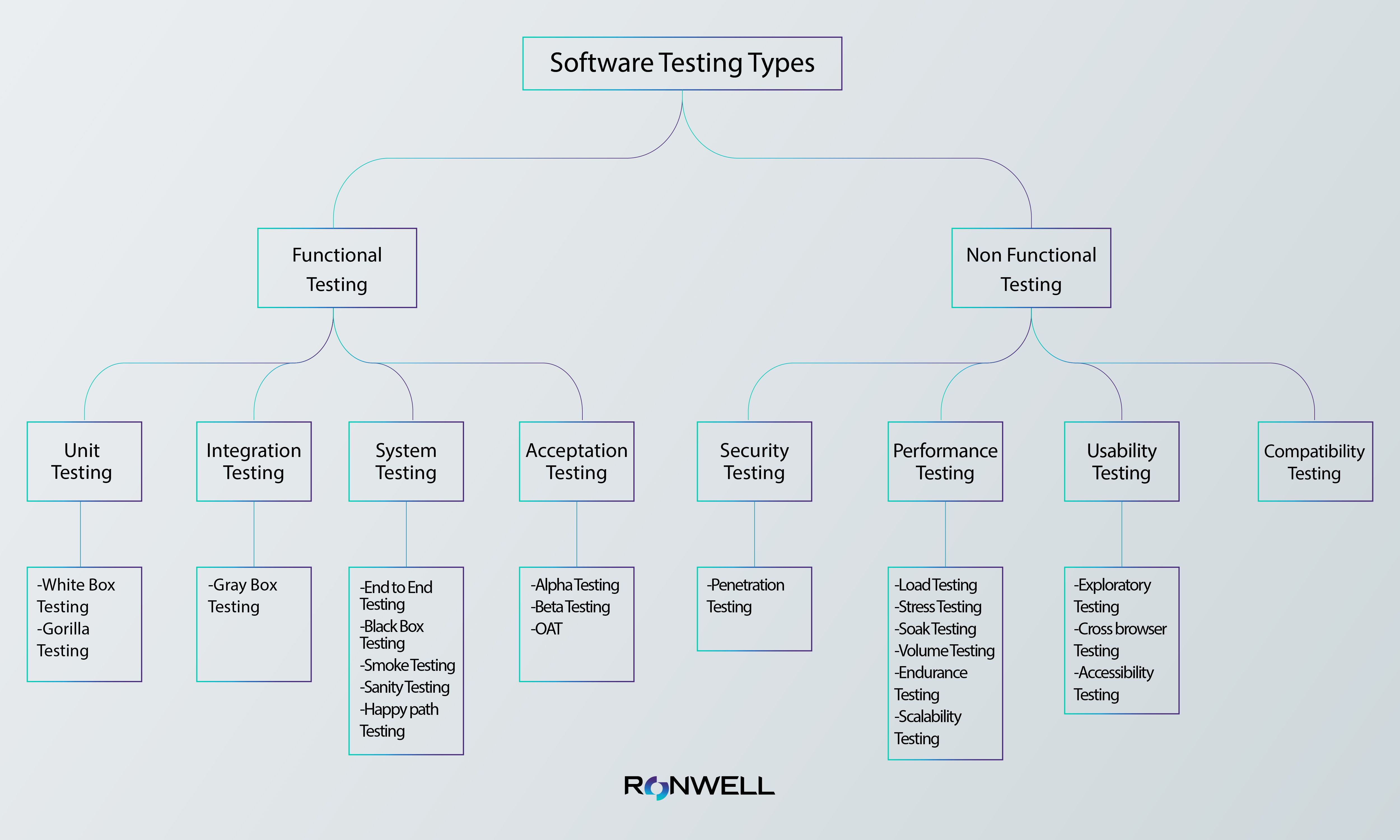

Our Services
Test Automation ServicesAI & Machine LearningBlockchainCRM ConsultingData Science & EngineeringDevOpsDigital MarketingDigital TransformationEmbedded Software DevelopmentERP Consulting ServicesManaged IT ServicesMergers & Acquisitions AdvisoryQA And Testing ServicesRobotic Process Automation SAP Consulting DevelopmentSoftware and Application DevelopmentSQL ConsultingStrategy ConsultingSustainability
- Contact Us
Our Services
- Test Automation Services
- AI & Machine Learning
- Blockchain
- CRM Consulting
- Data Science & Engineering
- DevOps
- Digital Marketing
- Digital Transformation
- Embedded Software Development
- ERP Consulting Services
- Managed IT Services
- Mergers & Acquisitions Advisory
- QA And Testing Services
- Robotic Process Automation
- SAP Consulting Development
- Software and Application Development
- SQL Consulting
- Strategy Consulting
- Sustainability
Insight
Company
Industries
- Contact Us

Discover the Ultimate Guide to Over 100 Types of Software Testing
Let’s explore 100+ different testing types in software that can be used to evaluate aspects of software functionality, usability, performance, security, and more!
- insight
- /
- blog
- /
- types-of-software-testing
Software testing is an important aspect of software development that ensures the quality of the software product before it is released to the market. There are many different types of software testing techniques, each with its own purpose and benefits.
In this blog, we will explore more than 100 different testing types that can be used to evaluate various aspects of software functionality, usability, performance, security, and more.
Whether you are a software developer, tester, or a quality assurance professional, this comprehensive guide will help you understand the different software testing types available and how to choose the right one for your software development project.
So, let's dive into the world of software testing and discover the various testing types in software that can help you build better products.

Basics of Software Testing
Here are the basic types of software testing:
Black Box
Test Engineers do black box testing, in which they verify the app's or software's ability to perform specified tasks based on input from the client. This testing is known as black-box testing since the source code is hidden from view throughout the testing process.
White Box
White-box testing is also called structural testing, testing in a glass box, testing in a clear box, or testing in a transparent box. This testing is conducted at the unit level and is based on the internal structure of the code. The test cases are made by looking at the system from the inside and using programming skills like code statements, conditions, branches, paths, and so on.
For more information about white box testing and black box, refers to the below link: Difference Between Black Box Testing and White Box Testing
Gray Box
Gray-box testing combines aspects of both black-box and white-box testing, by testing a piece of software against its specification while also having some knowledge of its internal workings. For making test cases, the testers will be able to look at design documents and internal code. In this case, functional testing is carried out.
Due to its focus on all of a system's layers, grey-box testing excels in identifying web-system faults that are unique to their environment. As a result, we may expand our test coverage. Gray-box testing is used largely in penetration and integration testing.
Gray box testing is typically performed by either development or testing teams who use specialized tools and techniques to gain insight into the software's internal workings.
Let’s deep dive into the different testing types.
Different Types of Software Testing
Acceptance Testing
There are three levels of testing that makeup acceptance testing: alpha, beta, and gamma. It's a formality that has to be done before you can go on with delivery and payment to the user.
The primary goal is to ensure that the final product meets all of the standards set out by the user before it is released to customers.
Automated Testing
A type of software testing that uses automation tools to automate test execution and results reporting. It is performed by a computer and helps in faster and more accurate testing. The testing team usually performs it.
More Resources for Automated Testing:
- How to Create Test Cases for Automated Tests? With Example
- 7 Automated Testing Tools For Web Applications in 2023
- Automation Testing: Market Size, Share, Trends & Dynamics
- What is Automation Testing? Types, Examples, Process
- How to Learn Automation Testing: 22 Free Online Courses
Ad-hoc Testing
This is a testing process that does not involve planning or documentation. It is a kind of unstructured or informal software testing that aims to disrupt the testing process in order to detect possible bugs or errors.
Testing in an ad hoc fashion is characterized by its lack of planning and reliance on existing documentation and test design approaches to generate test cases.
Alpha Testing
This type of testing is carried out at the developer's site for a software product or system. End-users typically perform this testing.
Active Testing
This is a testing method that involves introducing test data and analyzing the results. The testing team usually conducts this type of testing.
Assertion Testing
This type of testing involves verifying if product requirements are met by checking the conditions. The testing team usually performs this type of testing.
Accessibility Testing
This type of testing assesses how usable a product is for people with disabilities, such as the blind, deaf, or mentally disabled. The testing process is performed by individuals with disabilities.
API Testing
This testing technique is similar to unit testing in that it targets the code level. However, QA teams usually perform API testing instead of developers.
This requires evaluating the Application Programming Interface (API) for input/output (I/O), functionality, performance, dependability, and security. Many API testing situations are simulated using automated testing techniques.
Read our blog to see more about the Top 20 Automation Testing Tools.
Agile Testing
This method of software testing adheres to the same concepts as agile software development, namely that it is iterative and incremental and attempts to create high-quality software rapidly.
Agile testing involves continuous testing throughout the development cycle, as well as regular testing and feedback loops to guarantee that the program fulfills client requirements.
Age Testing
This type of testing assesses a system's ability to perform in the future. Testing teams carry out this evaluation process.
All-pairs Testing
All-pairs testing is a method that involves testing all possible combinations of discrete input parameters. Testing teams usually perform this type of testing.
Backward Compatibility Testing
A testing method that checks the behavior of new software with older versions of the test environment. It ensures that new changes do not impact the functionality of the older system.
Beta Testing
Beta testing is a type of user acceptance testing that is performed by a group of external users who have been invited to test a software product before it is released to the general public. It is typically the final phase of testing before a product is launched, and it is designed to gather feedback from real users on the usability, and overall quality of the product.
Beta testing can help identify bugs and usability issues that may not have been caught during earlier testing phases, and it can also provide valuable insight into how users will actually interact with the product.
Benchmark Testing
Benchmark testing is a type of testing used to evaluate the performance, speed, accuracy, or other aspects of a system, device, or software application. It involves running a series of tests under controlled conditions and comparing the results to a set of predefined standards or benchmarks.
The goal of benchmark testing is to identify any areas where the system or software falls short of the expected performance levels, and to optimize it for better performance. This type of testing is often used in industries such as computer hardware, gaming, and software development, where speed and performance are critical factors.
Basis Path Testing
A testing mechanism that measures the logical complexity of a procedural design and helps define the basic set of execution paths. Testing teams use this technique to define test cases.
Boundary Value Testing
A software testing technique that focuses on testing input values that lie on the boundaries of valid and invalid input ranges. The QA testing team performs it to ensure that the system handles boundary values correctly.
See more: What Does QA Stand For in Software?
Binary Portability Testing
A testing technique that tests an executable application for portability across different system platforms and environments. Testing teams use this technique to ensure that the system conforms to an ABI specification.
Bottom-Up Integration Testing
Bottom-up integration testing is a type of testing approach used in software development where individual components or modules are first tested independently, and then gradually integrated and tested together in a hierarchical manner until the entire system is fully integrated and tested.
Big Bang Integration Testing
A testing technique that integrates individual program modules only when everything is ready. Testing teams perform this technique to save time, but it may lead to difficulties in identifying and resolving defects.
Browser Testing
This testing verifies that online apps and websites are compatible with many web browsers, including Chrome, Firefox, Internet Explorer, Safari, etc.
It comprises evaluating the layout, design, function, and performance of the website across a variety of browsers and devices. This is vital for ensuring that web-based apps and websites are accessible to a larger audience and provide a consistent user experience.
Branch Testing
A testing technique that tests all branches in the program source code at least once. It is done by the developer to ensure that all possible paths of the code are tested.
Breadth Testing
This is a type of testing that verifies the functionality of a product without testing features in detail. It is used to ensure that the product works as expected across its full range of functionality. It is typically performed by testing teams.
Compliance Testing
Compliance testing is a type of testing used to ensure that a software application or system meets certain regulatory or industry-specific standards, such as legal requirements or best practices.
The primary goal of compliance testing is to verify that the system or application adheres to the guidelines and standards set forth by the relevant regulatory bodies or industry associations.
The testing process involves evaluating the software application or system against a set of compliance requirements, which may include security standards, accessibility guidelines, data privacy laws, or other regulations specific to the industry or region.
Code-Driven Testing
This type of testing uses testing frameworks, such as xUnit, to execute unit tests and ensure that various sections of the code are functioning as expected under different conditions. This type of testing is typically performed by development teams.
Comparison Testing
This type of testing compares the strengths and weaknesses of a product with previous versions or similar products. It can be performed by testers, developers, product managers, or product owners.
Compatibility Testing
Compatibility testing is a type of software testing used to evaluate the compatibility of a software application or system with various hardware, software, or operating system configurations.
The purpose of compatibility testing is to ensure that the application or system works as intended on different platforms, devices, and configurations, and to identify any compatibility issues that may arise.
Compatibility testing involves testing the application or system on a range of platforms and configurations, and verifying that it functions as expected and meets the specified requirements.
Configuration Testing
This method verifies the adaptability of a product or application across a variety of environments.
In order to find configuration-related errors or unexpected behavior or performance, software products are tested on a variety of hardware, operating systems, browsers, network setups, and other software components.
Concurrency Testing
It is a software testing type used to evaluate the performance and reliability of a software application or system under conditions of concurrent user or data access. In other words, it tests how well the application can handle multiple users or processes accessing the system simultaneously.
Concurrency testing involves simulating multiple users or processes accessing the system at the same time, and then measuring how well the system performs under these conditions.
The goal is to identify any issues that may arise, such as deadlocks, race conditions, or other problems related to the simultaneous access of shared resources.
Context Driven Testing
It is an approach to software testing that emphasizes the importance of testing in the context of the specific situation, environment, and objectives of the project.
The context-driven approach acknowledges that testing is a complex and dynamic process that depends on a variety of factors, such as the goals of the project, the user requirements, the available resources, and the skills and experience of the testing team.
Condition Coverage Testing
This type of testing involves executing each condition by making it true and false at least once in each of the ways. It is typically performed by automation testing teams.
Component Testing
Component testing is a type of software testing that focuses on testing individual software components or modules in isolation, rather than testing the entire system as a whole.
The main objective of component testing is to ensure that each component of the system works as intended and meets its functional and non-functional requirements.
Conformance Testing
This involves testing whether an implementation conforms to the specifications on which it is based. It is typically performed by testing teams and is important for ensuring that the system functions as expected.
Conversion Testing
This type of testing is used to ensure that programs or procedures used to convert data from existing systems to replacement systems are working properly.
It is typically performed by QA teams and is important for ensuring data is properly migrated from one system to another.
Dependency Testing
It is a software testing type that focuses on identifying and testing the dependencies between different components or modules of a software system.
Dependencies can be either software dependencies, where one component or module depends on the output of another component or module, or hardware dependencies, where the software depends on the hardware configuration of the system.
It is usually performed by testing teams and is important for ensuring that all dependencies are properly accounted for.
Dynamic Testing
This is a software testing technique that involves testing the dynamic behavior of code. It is typically performed by testing teams and is important for ensuring that the system behaves as expected under various conditions.
Decision Coverage Testing
This involves testing each condition or decision by setting it to true or false at least once. It is typically performed by automation testing teams and is important for ensuring that all possible code paths are tested.
Domain Testing
This is a white box testing technique that involves testing the program to ensure that it only accepts valid input. It is usually done by software development teams and occasionally by automation testing teams. This is important for ensuring that the system is secure and is not vulnerable to attacks or misuse.
Destructive Testing
This type of testing involves carrying out tests until the specimen fails, in order to understand its structural performance or material behavior under different loads. It is usually performed by QA teams and is important for ensuring that products are robust and reliable under various conditions.
End-to-End Testing
This involves testing a complete application environment in a situation that mimics real-world use, such as interacting with a database, using network communications, or interacting with other hardware, applications, or systems if appropriate.
It is typically performed by QA teams and is important for ensuring that the system functions properly in a real-world environment.
Error-Handling Testing
This involves testing the system's ability to properly process erroneous transactions. It is usually performed by testing teams and is important for ensuring that the system can recover from errors and continue functioning properly.
Endurance/ Soak Testing
This type of testing involves subjecting a software application to sustained or prolonged use in order to detect any memory leaks or other problems that may occur during long-term use.
Endurance testing is typically performed by performance engineers using specialized tools and techniques to simulate real-world usage scenarios.
Exploratory Testing
This is a black box testing technique that is performed without planning or documentation. The aim of exploratory testing is to uncover defects and issues that may not be immediately apparent through other testing methods.
It is performed by manual testers who use their expertise and experience to explore the software in an ad-hoc and unscripted manner.
Equivalence Partitioning Testing
This software testing technique involves dividing the input data of a software component into partitions of data from which test cases can be derived.
The aim of equivalence partitioning testing is to reduce the number of test cases required to achieve a certain level of testing coverage. It is usually performed by QA teams who use tools and techniques to identify the different partitions of input data.
Functional Testing
It is a black box testing type based on the specifications of the software component under test. The main aim of functional testing is to ensure that the software behaves as expected and meets the functional requirements specified.
It is usually performed by testing teams who use a range of techniques and tools to validate the functionality of the software.
Formal Verification Testing
This testing method involves using formal methods of mathematics to prove or disprove the correctness of algorithms underlying a system with respect to a certain formal specification or property.
Formal verification testing is typically performed by QA teams who have expertise in formal methods and specialized tools to perform the verification.
Fuzz Testing
This is a software testing technique that involves providing invalid, unexpected, or random data to the inputs of a program. Fuzz testing is a type of mutation testing and is performed by testing teams who use specialized tools to generate and input the test data.
Fault Injection Testing
This type of testing involves intentionally introducing faults or errors into a software system to evaluate how well it can handle unexpected conditions or exceptions. Fault injection testing is typically performed by QA teams who use specialized tools and techniques to simulate different fault scenarios.
Gorilla Testing
This testing technique focuses on heavily testing one particular module of a software system in order to detect any defects or issues that may arise from its use. Gorilla testing is typically performed by QA teams who use specialized tools and techniques to target the particular module of the system.
Learn how to Test Planning: The A-to-Z Guide.
Globalization Testing
This testing method checks the proper functionality of a product with any of the culture/locale settings using every type of international input possible. Globalization testing is typically performed by teams using specialized tools and techniques to simulate different international settings and input data.
Glass Box Testing
This is similar to white box testing, but it focuses more on the internal logic of the software's code rather than its functionality. Glass box testing is typically performed by development teams who use specialized tools and techniques to validate the software's internal workings.
GUI Software Testing
This testing methodology focuses on testing the graphical user interface (GUI) of a software product to ensure that it meets its written specifications. GUI software testing is typically performed by testing teams who use a range of techniques and tools to validate the GUI's behavior.
Hybrid Integration Testing
Hybrid Integration Testing is a powerful software testing technique that combines top-down and bottom-up integration techniques to leverage the benefits of both. This approach is typically performed by dedicated testing teams to ensure that software modules work together seamlessly, and any issues are identified and addressed early in the testing process.
Interface Testing
Interface Testing is another essential testing process that evaluates whether different systems or components are passing data and control to each other correctly. Both testing and development teams typically perform this testing process to ensure that software components are working together correctly.
Looking for Best Software Testing Books in 2023?
Integration Testing
Integration Testing is a crucial phase of software testing that involves combining individual software modules and testing them as a group to ensure that they work together as expected.
This process is typically conducted by testing teams to identify and resolve any issues that may arise when modules are combined.
Inter-Systems Testing
Inter-Systems Testing is a testing technique that focuses on ensuring that the interconnection between application functions works correctly. It is performed by testing teams to ensure that the application works seamlessly.
Internationalization Testing
Internationalization Testing is a critical process that ensures a product's functionality is not broken when used in different languages and locales.
Testing teams typically perform this testing to ensure that products work seamlessly in different parts of the world.
Keyword-Driven Testing
Keyword-driven Testing is an automated testing methodology that separates the test creation process into two stages: Planning and Implementation. This technique can be used by both manual and automation testing teams to ensure that the testing process is efficient and effective.
What is the difference between Manual testing vs. automated testing? Read our blog.
Install / Uninstall Testing
Install/uninstall Testing is a quality assurance process that focuses on ensuring that customers can install and set up new software successfully.
This testing may involve partial, full, or upgrade installs and uninstalls and is typically conducted by software testing engineers in conjunction with configuration managers.
Localization Testing
Localization Testing is a software testing process that focuses on adapting a globalized application to a particular culture/locale. This testing is typically performed by testing teams to ensure that the application meets local language, cultural, and legal requirements.
Loop Testing is a white box testing technique that exercises program loops. Development teams typically perform this testing to ensure that programs operate as expected and identify any issues with loops.
Load Testing
Load Testing is a testing technique that puts a system or device under demand to measure its response. Performance engineers typically conduct this testing to ensure that software applications can handle high traffic loads and operate efficiently under pressure.
You can also read our blog: The Ultimate List of Load Testing Tools for Seamless Performance.
Manual Scripted Testing
Manual Scripted Testing is a testing method in which the test cases are designed and reviewed by the team before executing them. Manual testing teams typically perform this testing to ensure that the software application meets the expected requirements.
Model-Based Testing
Model-Based Testing is a software testing process that uses Model-based design to create and execute artifacts necessary for testing. Testing teams typically perform this testing to ensure that the software application meets all the necessary requirements.
Manual-Support Testing
Manual-Support Testing is a testing technique that involves testing all the functions performed by people while preparing and using data from automated systems. Testing teams typically conduct this testing to ensure that the software application operates as expected and that all manual functions work seamlessly with the automated system.
Modularity-Driven Testing
Modularity-driven Testing is a software testing technique that involves creating small, independent scripts that represent modules, sections, and functions of the application under test.
Testing teams typically perform this testing to ensure that the software application operates as expected and that all modules and functions work together seamlessly.
Mutation Testing
Mutation Testing is a software testing method that involves modifying a program's source code or byte code to test sections of code that are seldom or never accessed during normal test execution.
Testers typically perform this testing to identify and address any potential issues with the software application.
Non-Functional Testing
Non-functional Testing is a software testing technique that focuses on testing a software application for its non-functional requirements.
Performance engineers or manual testing teams can conduct this testing to ensure that the application meets all non-functional requirements such as scalability, reliability, and maintainability.
Negative Testing
Negative Testing is a technique where the goal is to intentionally make a component or system fail. This is often done by manual or automated testers to identify weak points in the software.
By intentionally trying to break the system, testers can uncover vulnerabilities and ensure that the software can handle unexpected scenarios.
Operational Testing
Operational Testing is a type of testing that evaluates a system or component in its operational environment. This means that the software is tested in the same environment that it will be used in by end-users.
This type of testing is typically conducted by testing teams to ensure that the software performs as expected in its intended environment.
Orthogonal Array Testing
Orthogonal Array Testing is a systematic and statistical approach to testing that can be used in various types of testing, including user interface testing, system testing, regression testing, configuration testing, and performance testing.
It involves testing a subset of all possible combinations of input parameters to identify defects and ensure that the software performs as expected.
Object-Oriented Testing
It is a software testing technique that focuses on verifying the behavior of individual objects and their interactions in an object-oriented programming (OOP) system.
It ensures that each object of the system works as expected, and that the communication and collaboration between different objects are well defined and consistent.
Passive Testing
This is a testing technique where the system is monitored without introducing any special test data.
This allows testers to observe the system's behavior in its natural state and identify any issues that may arise.
Pair Testing
This testing is a collaborative software development technique where two team members work together at one keyboard to test the software application. One person does the testing while the other reviews and analyzes the testing. This can be done between a tester and developer, business analyst, or between two testers with both participants taking turns at driving the keyboard.
This approach can lead to better testing coverage and improved communication between team members.
Path Testing
This is a type of white box testing that involves testing each logical path through a program to ensure that each path meets the specified coverage criteria.
This type of testing is performed by the development team to ensure that the software meets the required specifications.
Learn about the principle of software testing.
Performance Testing
Performance Testing is a type of functional testing that evaluates a system or component's compliance with specified performance requirements.
This type of testing is typically conducted by a performance engineer to ensure that the software meets the required performance standards.
Penetration Testing
Penetration Testing is a technique used to evaluate the security of a computer system or network by simulating an attack from a malicious source.
It is conducted by specialized penetration testing companies to identify vulnerabilities in the system and ensure that appropriate security measures are in place.
Parallel Testing
Parallel Testing is a technique used to ensure that a new application that has replaced an older version has been installed and is running correctly.
It is generally run by the testing team to ensure that the new application is functioning properly and that there are no issues with the installation.
Qualification Testing
Qualification Testing is a type of testing that verifies that the software meets the specifications of the previous release.
This type of testing is mainly conducted by the developer to ensure that the software meets the customer's requirements.
Ramp Testing
Ramp Testing is a type of testing where an input signal is continuously raised until the system breaks down.
It is mostly conducted by the testing team or the performance engineer to identify the limits of the system and ensure that it can handle high volumes of data.
Recovery Testing
This testing method evaluates how well a system can recover from crashes or other catastrophic problems such as hardware failures. It is a critical process that ensures the system can resume normal functioning even after unexpected failures.
Recovery testing is performed by testing teams who simulate failures and then evaluate how well the system recovers from them. This testing is essential for identifying any gaps in the recovery process and improving the system's overall resilience.
Requirements Testing
This testing technique ensures that the software requirements are accurate, complete, and consistent with the intended functionality. It helps identify any ambiguities or inconsistencies in the requirements and ensures that a sufficient set of test cases is designed to validate them. Requirements testing is performed by QA teams who analyze the requirements documents and design test cases based on them.
This technique helps reduce the risk of incorrect software functionality and ensures that the final product meets the customer's expectations.
Regression Testing
Regression Testing is a type of testing that seeks to uncover software errors after changes to the program, such as bug fixes or new functionality, have been made.
This testing is typically performed by the testing team to ensure that the software continues to function as expected after changes have been made.
To learn more about Smoke Testing vs Regression Testing: Key Differences, read our blog.
Smoke Testing
Smoke testing, also known as "build verification testing," is a type of software testing that verifies whether the software build is stable enough to undergo further testing. It is a preliminary test that checks the basic functionality of the software system without going into details.
The goal of smoke testing is to identify critical defects that could prevent further testing and development.
Scalability Testing
This technique evaluates a software application's ability to handle increased user load, transaction volume, and data volume, among other factors. It is performed by performance engineers who simulate various scenarios and evaluate the system's performance under different conditions.
Scalability testing helps identify any bottlenecks or limitations in the system and provides insights on how to improve it.
Sanity Testing
This testing technique determines if a new software version is functioning well enough to undergo major testing efforts. It is a quick and straightforward process that evaluates the basic functionality of the system to ensure that it meets minimum standards.
Sanity testing is performed by testing teams who quickly evaluate the new version and provide feedback to developers. It helps prevent the waste of time and resources on testing a version that is not ready for major testing efforts.
Scenario Testing
This testing technique uses hypothetical stories or scenarios to evaluate the system's performance in complex situations. It helps identify potential problems that may arise in real-world scenarios and allows for the design of test cases that reflect these situations.
Scenario testing is performed by testing teams who create hypothetical stories and evaluate the system's performance based on them. It helps reduce the risk of system failures in complex situations and improves the overall performance of the system.
See also: Test Automation Strategy: Importance, Benefits & Example
Storage Testing
Storage testing is a crucial type of testing that ensures that the program under test correctly stores data files in the appropriate directories and has sufficient space to prevent unexpected termination due to a lack of space.
The testing team usually performs this testing, and it helps to identify issues related to storage before the software is released to the end-users.
Security Testing
This process evaluates the security of an information system to ensure that it protects data and maintains functionality as intended. Security testing can be performed by testing teams or specialized security testing companies who simulate attacks from malicious sources to identify any vulnerabilities in the system.
This technique helps prevent potential security breaches and reduces the risk of data theft or loss.
Read and be a Master the Art of Quality Assurance with These 7 Powerful Principles of Software Testing!
Static Testing
This testing method is used to check the sanity of code, algorithms, or documents without actually running the software. It is performed by developers who review the code or document to ensure that it meets specific requirements and standards.
Static testing helps identify potential problems early in the development process, reducing the risk of issues later on.
Structural Testing
Structural testing is a white box testing technique that considers the internal structure of a system or component to ensure that each program statement performs its intended function. This testing technique is usually conducted by software developers to detect errors in code logic, control flow, and other programming aspects.
Stress Testing
Stress testing is a powerful testing technique that evaluates how a system or component performs at or beyond the limits of its specified requirements. The performance engineer generally conducts this testing to identify system failure points and to ensure that it can handle the expected load.
Learn More: 5 Failures in Test Automation: Best Practices for Dealing with Them
Statement Testing
This white-box testing technique ensures that every statement in a program is executed at least once during testing. It is performed by the development team and helps identify any dead code or unused statements in the program.
Statement testing is essential for ensuring that the program is optimized and runs efficiently.
System Testing
System testing is the process of testing an integrated hardware and software system to verify that it meets the specified requirements. Testing teams perform this type of testing in both development and target environments. System testing is critical for detecting defects, ensuring compliance with the system's requirements, and enhancing the overall system performance.
System Integration Testing
System Integration Testing is a testing process that assesses how well a software system coexists with other software systems.
The testing team usually performs this testing to identify interface defects, data exchange issues, and other system integration problems.
Spike Testing
To ensure that the system continues to function normally, Spike Testing artificially increases the load on it at regular intervals.
Top-Down Integration Testing
Top-Down Integration Testing is a testing technique that starts testing from the top of a system hierarchy, typically the user interface, and uses stubs to test from the top down until the entire system has been implemented.
Testing teams perform this testing to ensure that the system meets its specified requirements, interfaces well with other systems, and that data flows correctly between the components.
Thread Testing
Thread testing is a variation of top-down testing, where the progressive integration of components follows the implementation of subsets of the requirements.
Testing teams usually perform this testing to evaluate how well the system handles multiple tasks or threads and to identify potential issues with thread synchronization, deadlock, or other concurrency-related problems.
User Interface Testing
User Interface Testing is a type of testing performed to check how user-friendly an application is. The testing team conducts this type of testing to evaluate whether the application's user interface is intuitive, easy to use, and meets the end-users' expectations.
Curious about Automated UI Testing: Best Practices, Benefits & Tools?
Upgrade Testing
Upgrade testing is a testing technique that verifies whether assets created with older versions can be used appropriately, and the user's learning is not affected.
The testing team generally performs this testing to ensure that the system's functionality, performance, and user experience remain intact after upgrading.
Unit Testing
Unit testing is a software verification and validation method in which a programmer tests individual units of source code to determine whether they are fit for use. The development team usually conducts this type of testing to detect coding errors, identify performance bottlenecks, and to ensure that the software functions as intended.
Wondering about Unit Testing vs Functional Testing: A Detailed Comparison?
Usability Testing
Usability Testing is a method of testing that assesses how easy it is for users to learn and operate a system or component, including preparing inputs and interpreting outputs. This type of testing is essential in ensuring that a product is user-friendly and meets the needs of its intended audience.
Usability testing can be conducted by end-users or other members of the testing team who represent the target audience. It involves observing users as they interact with the system and gathering feedback on their experience.
Vulnerability Testing
Vulnerability Testing is a type of testing that focuses on identifying and preventing security vulnerabilities in a software application. This type of testing is crucial in ensuring the security and integrity of an application.
It can be conducted by an internal testing team or outsourced to a specialized security testing company. Vulnerability testing involves identifying potential security threats and testing the system's ability to prevent them.
Volume Testing
Volume Testing is a type of testing that verifies the capability of a software application to handle large amounts of data over time, without causing any performance degradation or system failure.
This type of testing is typically performed by the performance engineer, and it helps to ensure that the program can handle large amounts of data and will not cause any problems for users. Volume testing involves generating large data sets to assess the application's performance under heavy loads.
Workflow Testing
Workflow Testing is an end-to-end testing technique that involves testing specific workflows that are expected to be utilized by the end-users. This type of testing is typically conducted by the testing team and involves scripting each step of the workflow.
Workflow testing helps to ensure that the system is functioning correctly and that the user can easily navigate through the various steps of the workflow. It is a crucial step in the overall testing process as it helps to identify any issues before the system is released to users.
Conclusion
So, software testing plays a crucial role in ensuring that software products are of high quality, reliable, and meet the needs of end-users.
With over 100 different types of software testing techniques available, software developers and testers have a range of options to choose from depending on the specific requirements of their projects. By using the right types of software testing, businesses can significantly reduce the risk of defects, improve the software's usability and functionality, and enhance the overall user experience.
We hope this comprehensive guide has provided you with valuable insights into the vast world of software testing and helps you in choosing the right testing types for your software development project.
If you're looking for a reliable testing partner, Ronwell Digital is an excellent choice!
With our expertise and dedication to delivering top-quality services, we can help your business achieve its testing goals and ensure the success of your software products.
Contact us today to learn more about testing services and how we can help your business thrive in today's competitive marketplace.
References
Guru99 - Types of Software Testing
Educative - Software Testing Types
Brainhub - Types of Software Testing
Zuci Systems - Types of Software Testing
IntelliPaat - Types of Software Testing
Writer:

Halime Yılmaz
Content Marketing Specialist
25 min read
29 March 2023, Wednesday
Related Posts
Related Industries
Related Services















